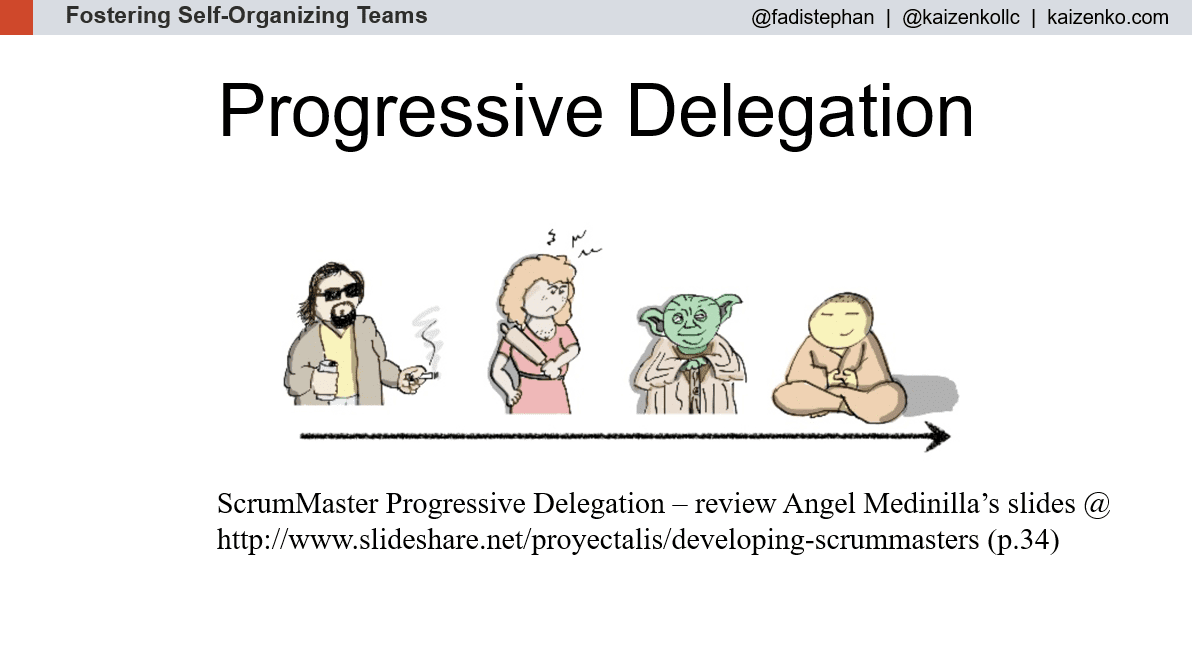Earlier when we discussed the ScrumMaster’s role is fostering a self-organizing team, I mentioned that the ScrumMaster needs to be self aware of her individual skills development journey and understand at what level of expertise she is at and work on moving to the higher levels so she can effectively help the team as a whole. In addition, an experienced ScrumMaster or servant-leader also understands team development models and adapts her leadership style as she helps the team transition through these stages to get them to a high performing stage as quickly as possible.
I like Angel Medinilla’a approach to this where he describes the ScrumMaster’s progressive delegation responsibilities. Angel identifies 4 types of ScrumMasters each with a different level of maturity and skill acquisition along with a different style of delegation.
The ScrumDude: This is a new ScrumMaster that just got certified and has no prior experience. He is at the Shu or novice/advanced beginner level. This is the cool dude, the nice guy that want to make sure everyone is happy and everything is going smoothly. He basically schedules meetings, coordinates the events and activities, updates the tool, chart and artifacts, takes notes, and provides status updates.
The ScrumMom: This is a more experience ScrumMaster that understands that the role is more than just a facilitator or coordinator. She is at the competent level and takes on the role of the protector of the team..She controls outside interference, always has the team’s back, removes impediments, identifies and resolves problems, avoids conflict, ensure tasks are assigned, and follows progress closely. Anything the team needs, she works tirelessly to provide for the team.
The ScrumMaster: This is a ScrumMaster that truly understands servant-leadership. She is at proficient level or ha level. She empowers the team, helps the team be accountable and responsible, gets the team to move from coordinating and cooperating to collaborating and performing, progressively delegates to the team, highlights problems and lets the team resolve them, ensures conflict remains constructive. She understands group dynamic and team development stages and is constantly aware at what level the team is at and adjusts her style accordingly. She focuses on learning and continuous improvement and is a strong advocate for change.
Agile Nirvana: This is a ScrumMaster at the expert or ri level. Her presence, insights, calmness, and thoughtfulness make everyone around her better. She just shows up, listens and reflects and things magically happen!
Review Angel Medinilla’s awesome slides starting at p34 at http://www.slideshare.net/proyectalis/developing-scrummasters
So what type of ScrumMaster are you? How are you changing your style to foster a high performing self-organizing team?
Also check out the complete Fostering Self-organizing Teams series:
- What is a Self-organizing Team?
- Scrum Magic! Do Scrum – Become Hype-productive!
- 3 Models for Skills Acquisition
- Shu Ha Ri
- The Dreyfus Model of Skills Acquisition
- Situational Leadership
- Tuckman’s Stages of Group Development
- Drexler/Sibbet Team Performance Model
- The ScrumMaster’s Role is Fostering a High Performing Self-Organizing Team
- 7 Attributes of a Self-Organizing Team
- Delegation Board for Fostering a Self-Organizing Team
- The ScrumMaster’s Progressive Delegation Responsibility
- Fostering Self-Organizing Teams Presentation
